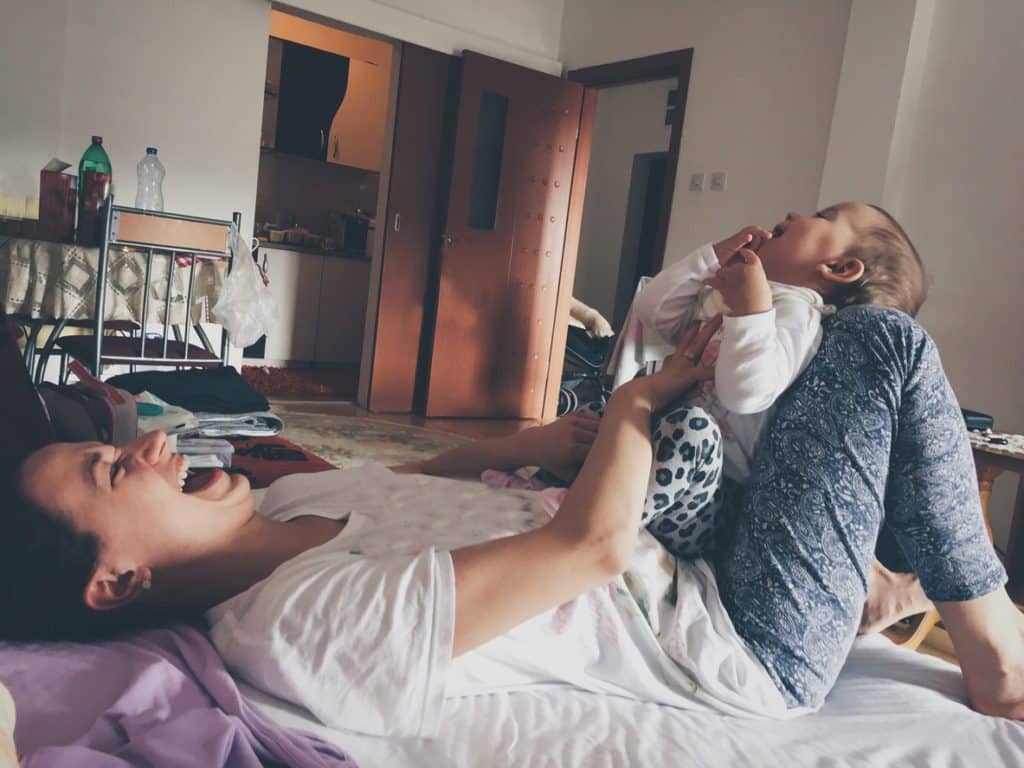Life with a newborn is an adjustment. It’s exhausting, repetitive, and at times overwhelming, but it is also absolutely wonderful. Your days consist of changing diapers, feeding baby, soothing baby, bathing baby, and putting baby to sleep. But once babies get a little older, they stay awake a little longer. Parents then begin to wonder what they should do with their babies. It’s not like they can move around, play, babble, or laugh with you. What are some things that you can do with your new baby? Here are 15 different great ways to engage with your baby.
1. Babywearing
There are so many benefits of babywearing. Not only is it good for babies (it helps them cry less, learn more, etc.), but it is amazing for moms. When you wear your baby, you can engage with your child closely and have the freedom to be hands-free! Whether you have a wrap, sling, or carrier, I highly recommend snuggling up close to your baby and wearing them. It makes things easier for you and soothes your little one.
2. Do Skin-to-Skin
We’ve talked about the power of touch many times on our site. Holding a baby close to you is a form of communication. It will not spoil your baby. It lets them know they are safe, secure, and cared for. When you hold your baby skin-to-skin, it is even better. Here are just a few of the many benefits:
- Helps baby’s senses develop.
- Stimulates baby’s psychological and emotional growth.
- Can boost baby’s immune system.
- Promotes bonding.
- Can help with diminishing postpartum depression in new moms.
- Regulates baby’s body temperature and heart rate.
- Can aid in tempering a new mom’s hormonal fluctuations.
- Encourages a positive sleep rhythm for baby.
Skin-to-skin can be done (and should be done) by both parents, not just the mother.
3. Baby Talk
From the moment babies are born, they are familiar with their parents’ voices.7 Your baby loves to hear you talk, and talking to your baby is extremely important for their future development. It builds their language foundation and contributes to how quickly they pick up talking.8 It’s been proven beneficial for babies to listen to normal speech patterns, cooing, and exaggerated baby talk.9 So talk to your baby. Tell them what you are doing, how you are feeling, and what you are thinking. They will sit there and eagerly listen.
4. Sing to Them
Even if you think you have the worst singing voice in the world, your baby will love it. They are hardwired to enjoy the sound of their parents’ singing voices. So sing to them! (We recommend picking something with a good tune and melody. Heavy metal won’t do the trick.)
Singing actually:
- Increases baby’s listening skills.
- Encourages language development and introduces new vocabulary.
- Can relax your baby.
- A wonderful way for a parent to express their love in a way baby will understand.
5. Read to Them
Reading does so much for babies and children, and it has been proven repeatedly by research.1,2,3 Of course, parents can strengthen their babies’ minds and build their children’s vocabularies by talking to them, but reading to them is even more effective. Reading aloud is the best way to help your child develop word mastery and grammatical understanding, which will, in the future, form the basis for learning how to read.
6. Go Outside
There is something about the great outdoors that babies love. Whether it’s the fresh air, birds chirping, or the change of scenery, they can’t get enough of going outside. Some parents worry that they are taking their babies outside too soon. However, as soon as a baby is born, it is fine for parents to take them outside or on errands.10 (Of course, be mindful and keep them away from potential health issues.) You will notice that your baby will become less fussy and more relaxed as soon as you walk them around outdoors. This is because they’re stimulated and engaged by the world around them and focusing on processing all the information.
7. Take Them Where the Action Is
Babies can get bored. If they are in the same place doing the same thing for too long, they will begin to cry out for a change of scenery. I recommend setting up your baby in the area of the house that gets the most action. This usually happens when other kids are home from school, around the kitchen getting ready for breakfast or dinner, or when dad comes home from work. Wherever that place is, place baby in a Bumbo, bouncer, or bassinet and let them soak in the conversations and interactions. This will give your baby free entertainment!
8. Add Some Color
Visual stimulation is crucial in infants. It is the only way the visual center in their brains will develop. Dr. Sears encourages parents to surround their babies with light and dark contrasting colors and interesting visuals. These contrasts will register more powerfully on their retina, and it will help their optic nerve, thus sending strong visual signals to their brain. If you were only to have neutrals and pastel colors around your newborn, Dr. Sears says that’s on par with keeping them blindfolded! Keep this in mind when designing your baby’s nursery and buying your baby toys.4
9. Color
I know this might sound dangerous, but coloring is a great way to engage and play with your baby. Strap your child into their high chair or hold them on your lap, and spread out some crayons and paper. Demonstrate how to make marks on the paper, then hand over a crayon. Many parents are afraid that the child will start scribbling all over the place, but a very young child can use crayons with supervision.
10. Infant Massage
The benefits of infant massage go above and beyond using touch to relieve gas or colic – although this is a definite plus! Massaging a newborn is a way for parents to communicate with their baby non-verbally. This gentle touch will help an infant develop trust, confidence, and familiarity with a parent. Plus, massage is a surefire way to stimulate all of baby’s senses, which aids in their rapid development.
11. Feel All the Things
Introduce a variety of textures to your baby. Allowing them to feel different textures is a great way to stimulate their sense of touch. You can show them various sensory toys, board books, blankets, playmats, and even the surrounding environment (sand, water, grass, etc.). This allows them to explore and learn. A parent can take it further by having baby touch a bumpy texture followed by saying the word “bumpy” or having them stroke fur while saying “soft.” Eventually, they will know to associate the word with the feeling.
12. Tummy Time
If you have done #allthethings with your baby, remember that your baby also needs to be doing enough tummy time. Pediatric recommendations for tummy time range from three to five minutes, two to three times a day.5 Whether it happens all at once or is spread throughout the day in smaller increments include tummy time in your baby’s day. Studies have shown that infants who get this amount of tummy time are quicker to reach milestones in the first years of life.6
13. Take a Class or Join a Support Group
Getting out of the house is excellent for you and your baby. You will have the opportunity to meet other moms with babies and do an activity you enjoy. Before committing to something, be mindful of your baby’s schedule (naps and mood throughout the day). Some examples are Mommy and Me yoga classes, a group exercise class such as Fit4Mom classes, a music class like Kindermusik, or a Float Baby class.
14. Take Them on a Tour
Whether in your home, at the grocery store, in your backyard, in Target, or wherever, walk them through, show them different things, and explain what they are looking at, what they are touching and hearing. They will love the private tour.
15. Take a Dip
Sometimes a good bubble bath with you and your baby is exactly what you both need. It’s a relaxing experience that is a perfect way to end the day. Play soothing music in the background or sing to your baby as you soak together in warm water. Add some bath toys and plastic cups if your baby is in a more playful mood. Whether you are relaxing your playing, it’s a great bonding experience. For safety reasons, be sure not to fill the tub too high and always hold your child firmly.





























